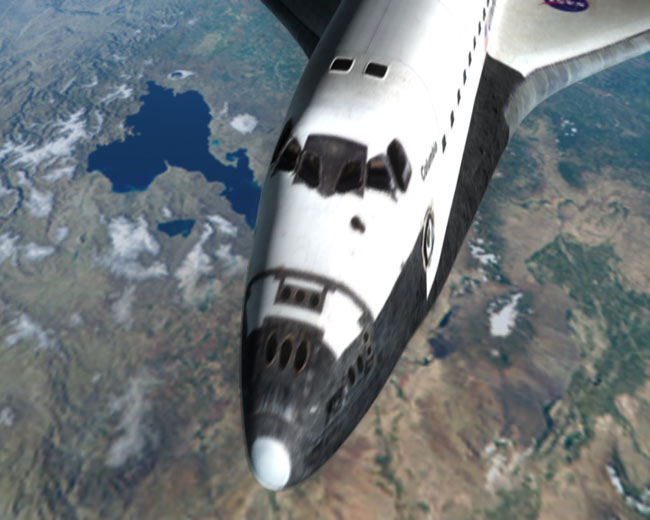TV Review: 'Seconds from Disaster: Columbia's Last Flight'

TheNational Geographic Channel will pick apart the steps and missteps that led upto the NASA's Columbia tragedy, which killed seven astronauts and destroyed oneorbiter, tonight during a one-hour program highlighting the disaster.
Using reenactments,computer graphics and a veritable mountain of research and investigationresults, "Seconds to Disaster: Columbia's Last Flight " recreates the finalminutes before the space shuttle Columbia broke apart during reentry and offersan in-depth look at the disaster's causes. The program is part of an ongoingseries that traces the cause of natural and manmade disasters.
In a way,"Columbia's Last Flight" picks up where an earlier documentary - "AstronautDiaries: Remembering the Columbia Shuttle Crew" - left off. Whereas thelatter program paints an intimate portrait of the seven astronauts who made upColumbia's ill-fated STS-107 crew, "Last Flight" focuses on the mechanics ofthe mission, as well as the accident at launch that proved fatal at thespaceflight's end.
During Columbia'sJan. 16, 2003 launch, a chunk of insulating foam the size of a suitcase separatedfrom the shuttle's external tank and struck the orbiter's left wing. While theincident, which engineers discovered after reviewing launch footage, did notaffect the liftoff or subsequent orbital spaceflight, it did gouge a hole inthe protective skin of Columbia's left wing leading edge.
Thatpuncture allowed hot gases to penetrate Columbia's wing as it reentered theEarth's atmosphere on Feb. 1, 2003, ultimately destroying the spacecraft andits crew. The accident grounded NASA's shuttle fleet for more than two years.The next shuttle flight, STS-114 aboard the Discovery orbiter, is slated tolaunch no earlier than July 13, 2005.
"LastFlight" follows not only those final moments of Columbia and its crew, but alsothe exhaustive search for wreckage and the months of investigation thatfollowed.
Everythingfrom the anxiety of mission controllers - most of whom appear in archivalfootage - described by spaceflight experts and astronauts, to a reenactment ofSTS-107 commander Rick Husband fighting for control of the orbiter as it breaksapart offer a poignant view of how NASA faces disaster. But much of the humanimpact from "Last Flight" comes from STS-107 family members, such as Jon Clark -husband to STS-107 mission specialist Laurel Clark.
Get the Space.com Newsletter
Breaking space news, the latest updates on rocket launches, skywatching events and more!
"There wereseveral people who made great, erroneous errors," Jon Clark says in "LastFlight." "You've got to look at those errors and rectify them. That is my hopefor human spaceflight."
While "LastFlight" seems to speed through the five months of investigations, tests andmore tests by NASA and other investigators to identify the root causes of theColumbia accident, it does highlight the space agency's non-mechanicalfailings, such as a bogged-down culture that suffered from safety "blind spots."
But had NASAofficials fully known at the time that the damage sustained by Columbia atlaunch could prove fatal, they would not have risked atmospheric reentry,experts explain.
"We wouldhave done something," says retired U.S. Navy Adm. Hal Gehman, who led theColumbia Accident Investigation Board, in "Last Flight."
Secondsto Disaster: Columbia's Last Flight airs at 9:00 p.m. ET/PT on the NationalGeographic Channel. Check local listings.
- Documentary Provides Intimate Look at Columbia's Last Crew
- TV Review - National Geographic's 'Extraterrestrial'
Join our Space Forums to keep talking space on the latest missions, night sky and more! And if you have a news tip, correction or comment, let us know at: community@space.com.

Tariq is the Editor-in-Chief of Space.com and joined the team in 2001, first as an intern and staff writer, and later as an editor. He covers human spaceflight, exploration and space science, as well as skywatching and entertainment. He became Space.com's Managing Editor in 2009 and Editor-in-Chief in 2019. Before joining Space.com, Tariq was a staff reporter for The Los Angeles Times covering education and city beats in La Habra, Fullerton and Huntington Beach. In October 2022, Tariq received the Harry Kolcum Award for excellence in space reporting from the National Space Club Florida Committee. He is also an Eagle Scout (yes, he has the Space Exploration merit badge) and went to Space Camp four times as a kid and a fifth time as an adult. He has journalism degrees from the University of Southern California and New York University. You can find Tariq at Space.com and as the co-host to the This Week In Space podcast with space historian Rod Pyle on the TWiT network. To see his latest project, you can follow Tariq on Twitter @tariqjmalik.









